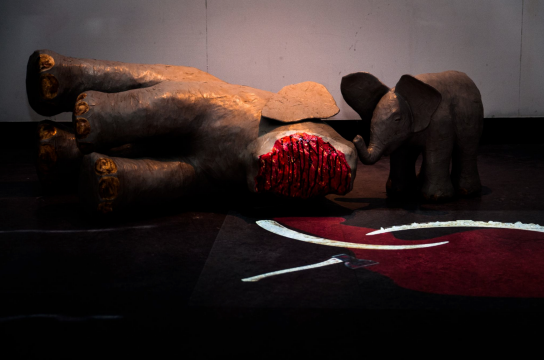By Griffy Vigneron (The Cascade) – Email
Print Edition: May 8, 2013
Anyone who walked into C building last week may have been met by a particularly bloody representation of greed-fuelled human brutality. “The Cost of Ivory,” a new media art piece designed by art student Julie Ruffel, is centred around a 60-pound paper mache elephant, its face completely sliced off.
Alongside the slaughtered elephant, a smaller baby elephant looks on in a heart-wrenching fashion. Alone and vulnerable, it is depicted clinging to the side of its fallen mother. Virtual blood that oozes from the fallen elephant’s face in the video is spread out over the floor, slapping viewers in the face with the horrors of the wealth driven ivory trade.
“The big point of the piece is the fact that the elephant’s face is cut off,” Ruffel explained. “Twenty-five per cent of an elephants ivory is under the skin, which is why [it’s done].”
Ruffel, an avid animal rights supporter, had found images online of defaced elephants slaughtered for their ivory. She described finding them particularly gruesome and felt the need to bring attention to the issue.
With her piece Ruffel said she “wanted to do something that physically put, literally, the elephant in the room with [the viewer].” Using old copies of The Cascade was not just a good idea because it was cheap and it was recycling, but because it allowed Ruffel to make something big and bold. Unlike a picture or video, a paper mache model put a real presence in the room. Ruffel wanted to make the experience as real as she could.
But her point was not to simply turn us away from the plight of the elephant aghast. Rather, she hopes to instill awareness.
“Elephant ivory poaching has gone through the roof lately. We have 12,000 African elephants that are being poached a year because of the growing market in China,” Ruffel explained. And the real kicker she said, is that “no one’s really doing anything [about it].”
“In China ivory is a source of status,” Ruffel noted. Wearing ivory shows others that you’ve got money. In our society it could be akin to wearing Gucci or Prada, or toting Louis Vuitton handbags.
“The problem is that there are legal markets in China that allow for ivory [sales]. Once you have a legal market people launder products illegally through it,” Ruffel described. A certain portion of ivory comes from other animals, or from treasure hunters who dig up the tusks of long dead woolly mammoths. These methods of gaining are ivory are considered legal; however, no average person is going to know the difference between legal ivory and elephant ivory.
And while Ruffel’s artwork speaks most directly of the fate of the elephant, she emphasized that her piece is not solely about elephants alone.
“An elephant is a huge animal, it has a huge impact on its ecosystem. If they’re gone, we don’t know what kind of damage that’s going to do,” Ruffel emphasized. Humans, and even the landscape itself, could experience drastic changes.
On top of which, Ruffel added, “Poaching animals has become a $20 billion per year industry for organized crime. There is more illegal animal wildlife poaching than there is illegal gun trade. It is second only to the drug trade, that’s how bad it’s gotten. It’s not just a couple of local hunters.”
The poaching industry that goes along with elephant slaughter often affects locals. Ruffel attributed a small fraction of elephant poaching to starving Africans. She explained that many locals are employed as rangers, and many of these rangers are killed every year protecting the animals from poaching.
“If people don’t care about the elephants, they should at least care about the people. There is a human impact absolutely,” Ruffel stated.
Her elephants unabashedly bring to life the realities of the cost of the ivory trade – on elephants and, indirectly, the human kind as well.


